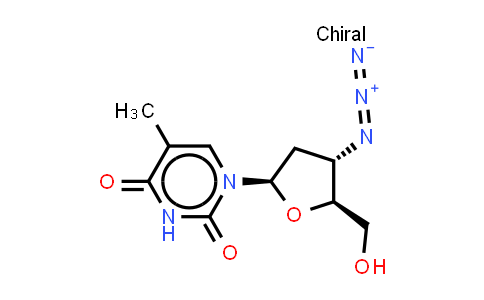
Zidovudine NLT 98%
SKU : MC547508
CAS Number : 30516-87-1
Molecular Formula : C10H13N5O4 | Molecular Weight : 267.24
Synonyms : Azidothymidine;AZT;ZDV
Quote Request| Purity | NLT 98% |
|---|---|
| Storage | at 20ºC 2 years |
* The above information is for reference only.
* If the product has intellectual property rights, a license granted is must or contact us.
| Chemical Name | Zidovudine |
|---|---|
| CAS Number | 30516-87-1 |
| MDL Number | MFCD00006536 |
| Molecular Formula | C10H13N5O4 |
| Molecular Weight | 267.24 |
| Synonyms | Azidothymidine;AZT;ZDV |
Zidovudine is a nucleoside reverse transcriptase inhibitor (NRTI), widely used to treat HIV infection. Zidovudine increases CRISPR/Cas9-mediated editing frequency. IC50 & Target: NRTI, HIV[1]
CRISPR/Cas9[2] In Vitro: Zidovudine inhibits SVG, Primary human fetal astrocytes (PFA), peripheral blood mononuclear cells (PBMC), and monocyte-derived macrophages (MDM) with EC50 of 17, 1311, 8, and 5 nM, respectively. Zidovudine inhibits SVG, PFA, PBMC, and MDM with EC90 of 0.205 μM, 44.157 μM, 0.481 μM, and 0.219 μM, respectively[1]. Genome editing via CRISPR/Cas9 has become an efficient and reliable way to make precise, targeted changes to the genome of living cells. CXCR4 is a co-receptor for the human immunodeficiency virus type 1 (HIV-1) infection and has been considered as an important therapeutic target for AIDS. CXCR4 mediates viral entry into human CD4+ cells by binding to envelope protein, gp120. Human CXCR4 gene is efficiently disrupted by CRISPR/Cas9-mediated genome editing, leading to HIV-1 resistance of human primary CD4+ T cells. The Cas9-mediated ablation of CXCR4 demonstrated high specificity and negligible off-target effects without affecting cell division and propagation[2]. In Vivo: Intravitrous injection of the NRTIs Lamivudine (3TC), Zidovudine (AZT), or Abacavir (ABC) suppresses the laser-induced choroidal neovascularization (CNV) in wild-type mice compared to PBS vehicle. The mean level of VEGF-A in the RPE/choroid, which peaks on day 3 after laser injury, is significantly reduced in 3TC-, AZT- and ABC-treated eyes compared with control eyes in wild-type mice, but not inP2rx7-/- mice[3].
Related Products
© Copyright 2015-2024 Hangzhou MolCore BioPharmatech Co.,Ltd. All rights reserved.
